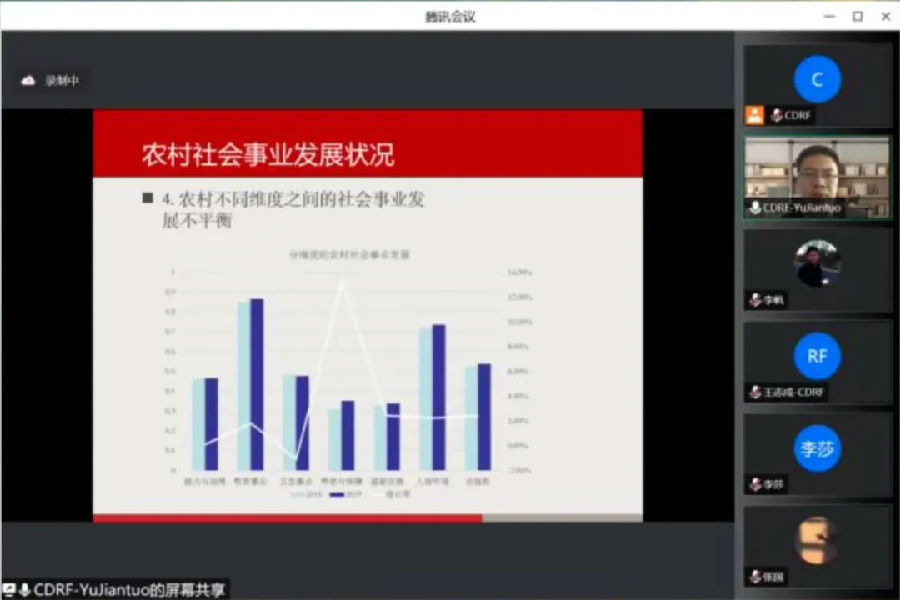China Rural Public Services Development Index Report Launched
On December 30th, 2022, the China Development Research Foundation released the China Rural Public Services Development Index Report in Beijing. Commissioned by the Department of Rural Social Development of Ministry of Agriculture and Rural Affairs, CDRF organized a research team to carry out index evaluation and case analysis. Yu Jiantuo, Deputy Secretary General, CDRF, presented the report, and Li Fan, director of research department I, moderated the press conference.
Based on the data of 31 provinces and municipalities and 200 sample counties across the country, the report evaluates rural public services development index in China, from six basic dimensions: capacity and governance, education, health care, pension and security, infrastructure and living environment.
From the assessment results, China’s rural public services have developed steadily. In 2019, the national average rural social development index reached 0.540, an increase of 2.42% over 2018. There is a solid foundation for the development of rural social development. The average level of rural social development index in the eastern, central and western regions has exceeded 0.5, and the trend of catching up in the central and western regions is obvious.
From the field case research, especially since the battle against poverty, the weakness of rural social development have been significantly strengthened. In 2019, the scores of the eastern, central and western indices were 0.589, 0.538 and 0.513, respectively, an increase of 0.86%, 3.46% and 2.81% over the previous year, which helped narrow the gap of rural social development between regions. The counties with the lowest level of development of rural social development in the western region showed relatively rapid growth, an increase of 5.33 percent over the previous year.
The report believes that the disparity in the development of rural social development within the three major regions deserves attention. From a regional perspective, the ratio of the highest and lowest counties in the eastern and western indices reached 1.896 in 2019, which nearly doubled. The intra-regional development gap for central China is the smallest of the three major regions, and the average is higher than that in the west China, but the counties with the highest scores in the western region are better than their counterparts in the central region.
There is also an imbalance in the development of rural social public services between different dimensions in rural areas. On average, among the six dimensions, infrastructure and pension and security have the lowest level of development, less than half of the scores of the education and living environment index. In recent years, China has made rapid progress in safe drinking water and sanitary toilets in rural areas, which has significantly improved the rural living environment. Dragged down by the poor performance of the two indicators of county government fiscal capacity and public service transparency, the capacity and governance dimensions are still short. In addition, the development gap within each dimension is more prominent. In the two dimensions of infrastructure, pension and social security, the ratio of the highest to lowest scoring counties in 2019 reached 10.433 and 6.571, and the development of education and health was relatively average.

From the perspective of provinces, Zhejiang and Jiangsu have outstanding performance in the development of rural social public services. All six selected sample counties in Zhejiang entered the top 10, and two county level cities in Jiangsu and Southern Jiangsu entered the top 3. Zhejiang Province becoming China's first high-quality development and common prosperity demonstration area is apparent. The development of rural social public services in Gansu, Yunnan, Xizang in the western region, and Shanxi in the central region still faces great challenges.
The report believes that it is necessary to fully understand the important value of rural social development to rural revitalization and promote common prosperity. The report suggests that in the future, it is necessary to strengthen the top-level design and cross-departmental coordination of the development of rural social public services, increase the financial guarantee for the development of rural social public services and innovate financing models, and make up for the shortcomings and weaknesses of the development of rural social public services. In addition, it is necessary to improve transparency in less developed counties and cities in the east and central regions, improve grassroots governance, mobilize the enthusiasm of local governments and rural residents, and promote participation and sharing in the development of rural social public services.




